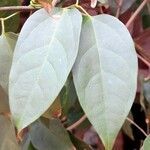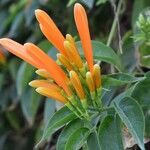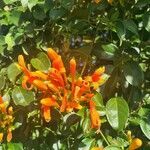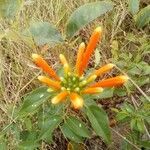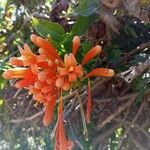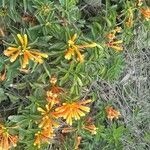Evergreen, vigorous woody climber; branchlets 6–8-ribbed, mostly ± glabrous. Leaves opposite, 4–10 cm long often with terminal leaflet modified into a coiled 3-branched tendril 5–15 cm long; leaflets 2 (or 3 when terminal leaflet present), ovate to lanceolate or ovate-elliptic/oblong, mostly 3–9 cm long and 2–4.5 cm wide, entire margin, acuminate apex, ± glabrous; petiole 5–15 cm long, sparsely hairy; petiolules 5–15 mm long. There may be a combination of compound-bifoliate leaves (often with a tendril between folioles/leaflets) and trifoliate leaves; the 3-tipped tendrils often coiling but absent from many leaves. Inflorescences dense cluster, 8–15 cm long. Calyx 4–7 mm long, almost entire to shallowly lobed and minutely 5-dentate. Corolla usually 5–7 (–8) cm long, orange or reddish orange; tube ± slightly curved, very narrow at base, broadening above; lobes 10–18 mm long, spreading to reflexed, margin and often upper parts of outer and/or inner surfaces hairy. Stamens slightly protruding. Capsule linear, 20–30 cm long, with numerous winged seeds; but apparently not set in Australia.
A woody vine. It is fast growing and keeps its leaves throughout the year. The leaves are compound with 2 or 3 oval leaflets. The leaves are in opposite pairs along the stem. The central leaflet can be a coiled tendril. The flowers are reddish-orange. They are tube shaped and 9 cm long. They are in clusters or 15-20 at the tips of the branches. The flower clusters often hang down. The fruit are slender dry capsules about 25 cm long.
Leaflets ovate-lanceolate, 4-6 by 3-4 cm. Thyrses dense, rachis 10 cm. Calyx 6-7 mm. Corolla tube c. 1 cm.
